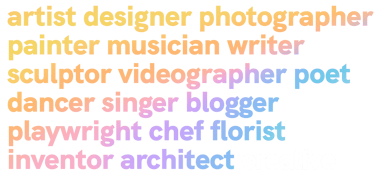
Latest Article: Bitcoin Isn't as Decentralized as You Think. Here's Why.
Financial Basics for Creatives: Budgeting, Accounting, Taxes, and More
Master your creative business finances! Learn to budget, track income and expenses, and conquer taxes. Free tools and resources for creatives. Easy to understand and implement.
BUSINESSJUMPSTARTINVESTINGACCOUNTINGTAX
David Kindness, CPA
4/24/2024



Financial Basics For Creatives: Budgeting, Accounting, Taxes, and More
Updated on April 23, 2024
Written by David Kindness, CPA
Why you can trust Your Creative CPA
Our content is written, edited, or both by industry experts who are creative entrepreneurs just like you. Learn more.
If you're feeling lost in a sea of financial terminology, like you're learning a new concept every day, then you're not alone. Running a creative business is a dream come true, but managing the financial side can feel overwhelming.
This article breaks down financial basics for creatives, like budgeting, accounting, taxes, and retirement. We'll make these topics understandable, and you'll be a master of the financial basics in no time. By mastering these concepts, you can achieve financial stability and focus on what you love: creating!
Fast Facts About Financial Basics
Budgeting is the process of tracking your income and expenses to see where your money goes and save for future goals.
Accounting allows you to organize your financial records so you know your business's health.
Knowing what taxes you owe will help you minimize your taxes and set aside money throughout the year to avoid surprises.
Understanding your retirement goals and how to save for them will set you up for success later in life.
Intro to Financial Basics
Imagine your finances as a map leading to your creative dreams, and the major locations on the map are the financial topics you need to understand. They include budgeting, accounting, taxes, investing, saving, retirement, and more.
Budgeting is like planning your route, tracking how much money comes in (income) and how much goes out (expenses). Accounting is like keeping a logbook, recording your financial transactions. Taxes are like tolls you pay along the way. Bookkeeping is like neatly organizing your receipts and documents. This article will equip you with the tools to navigate your creative financial journey with confidence!
Intro to Budgeting for Creatives
When most of us think of a budget, the word "fun" doesn't come to mind. But a logical, functional budget can be your key to achieving a life full of fun because it frees up your financial resources to spend on things that truly matter to you, like pursuing your art, traveling, marketing your business, or spending more time with loved ones.
Think of a budget as a spending plan. It helps you track your income, like sales from your online store or client payments for your design work, and your expenses, like rent, web hosting, software subscriptions, or art supplies. By understanding where your money goes, you can save for things like marketing campaigns, new equipment, a better website, creative education, or that dream trip.
Here's how to get started:
List your income sources: this could include sales from your website, client fees, royalties, ad revenue, or other income. Also, list the amount you receive each month and each year.
List all of your expenses: create a list of everything you spend on your business for a month. You can also do this for your personal life. Include things like rent or mortgage, car insurance, business insurance, utilities, internet and phone, office supplies, equipment, and more.
Use a budgeting app: There are many free and easy-to-use budgeting apps to help you visualize your spending. Our resources page lists some great options.
Set realistic savings goals: Decide how much you want to save each month and do your best to stick to it. This may seem challenging or stressful in the beginning, but over time it will lead to lower stress, more cash on hand, and more financial freedom. And if you fall short every once in a while, don't worry. Doing your best to be consistent over a long period of time is the key to success.
Action Item: check out our creative income cheat sheet and creative expense cheat sheet (both of which are free!) for a useful, comprehensive list of common income and expense items for your business.
Intro to Accounting for Creatives: Keeping Your Books in Order
Accounting might sound intimidating, but it's simply organizing your financial records. This includes things like recording income and expenses (AKA bookkeeping) and generating financial statements, like an income statement and a balance sheet. The goal of accounting is to give you an accurate picture of your business's health at any time.
Here's what you need to know:
Bookkeeping is key: Use a spreadsheet (like Google Sheets) or a free accounting software to track your income and expenses.
Keep good records: Save receipts and invoices in an envelope or file folder. This will allow you to double-check expenses in the future, and you can use them to verify expenses for tax purposes.
Utilize accounting software: Explore free or affordable options to streamline bookkeeping. Accounting software allows you to simply enter an expense and choose an expense category, and the software will do the rest. Accounting software can create financial statements, give you useful summaries, and help you prepare your tax return.
Action Item: Choose a bookkeeping system (spreadsheet or software) and commit to recording your income and expenses daily or weekly. Save receipts in an envelope or file folder to verify your expenses for tax purposes. Check out our resources page for YCCPA's favorite accounting software options.
Intro to Taxes for Creatives: Understanding Your Tax Bill
As a creative freelancer or business owner, you're responsible for paying taxes on your business income. But there's good news: you can deduct many business expenses from your taxable income, which lowers your tax bill and saves you money.
Creative business owners must pay a few different types of taxes throughout the year. These include income tax, self-employment tax, and if you sell products, you may have to pay sales tax (depending on your location). Let's define each of these taxes below:
Income tax: income tax is the tax you pay on your net income (total income minus business expenses). The rate you pay will depend on how much money you make and which tax bracket you're in. If you have a job and run your creative business on the side, your business's net income will be combined with your W-2 income.
Self-Employment Tax: As a freelancer, you're responsible for paying both the employer and employee portions of Social Security and Medicare taxes. This is typically around 15.3% of your net income.
Sales Tax: If you sell taxable goods or services, you might need to collect and remit sales tax to your state. The specific rules and rates will vary by location, and if you sell in multiple locations, then you may need to pay sales taxes in each location.
We recommend using a reputable tax preparation software to make filing your taxes fast, efficient, and error-free. Tax software will calculate your taxes automatically and allow you to file your return with the click of a button. Some great options include TurboTax, TaxSlayer, and TaxAct, although there are many more on the market. Our Resources page lists some of our favorites.
Intro to Retirement Strategies for Creatives
While the freedom and flexibility of running your own creative business are incredible, planning for retirement can feel like a distant afterthought. However, securing your financial future is essential to ensure you can continue living your creative life comfortably well into your golden years. It also reduces your stress and gives you the ability to make long-term choices for your future.
There are several different types of retirement accounts available for creative freelancers and small business owners. These include Solo 401(k)s, SEP IRAs, Traditional or Roth IRAs, and good-old personal investing. Let's explore each of these below.
Solo 401(k): This retirement plan option is specifically designed for self-employed individuals and offers high contribution limits. You can contribute both as an employer and employee, maximizing your retirement savings.
SEP IRA: Another option for self-employed individuals, SEP IRAs allow for high contribution limits and simpler administration compared to a solo 401(k).
Traditional or Roth IRA: These individual retirement accounts offer tax advantages for retirement savings. Traditional IRAs offer tax-deductible contributions and tax-deferred growth, while Roth IRAs offer tax-free withdrawals in retirement (with some limitations).
Investing: Consider investing a portion of your income for long-term growth. There are various investment options available, from stocks and bonds to real estate. It's crucial to research and choose investments aligned with your risk tolerance and financial goals.
But how do you start investing in a retirement account? Well, there are a number of companies offering retirement accounts to entrepreneurs. These include Sofi, Vanguard, Fidelity, Charles Schwab, and more. Check out our Resources page for our favorite retirement account options.
How to Price Your Products and Services
Knowing how to price your creative products or services is challenging, but thoughtful pricing is crucial for your financial success. You should take into account how much your products or services cost, how much your competition is charging, the percentage margin you want to earn, and the financial goals you're working towards. Let's break down each of these elements below...
How Much Does Your Product or Service Cost?
First, consider all the expenses involved in creating your product or service.
For physical products, your cost includes the manufacturing cost, shipping, and packaging, as well as the time you spend designing, packing, and mailing the product.
For Services, your cost includes a portion of the equipment (cameras, lenses, computers, easels, machines, instruments, etc) you use, software subscription fees, travel expenses, digital storage space, and marketing materials.
What is Your Competition Charging?
Consider how much your competition is charging for the same (or similar) products or services. The amount you charge will depend on what others are charging - at least to some degree. Customers may be willing to pay extra for your brand, but once the price gets too high, they're likely to switch to cheaper alternatives. You may be able to increase your brand's value by
Add a Profit Margin To Your Price
Add a profit margin to your cost to cover your living expenses and make a sustainable income. A profit margin is the percentage of the total amount you charge that you'd like to keep as profit. For example, if you charge $1,000 for your services, and you keep $400 of it after deducting expenses, then your profit margin is 40% ($400 ÷ $1,000). As a general rule, try to charge a profit margin of at least 20%, and ideally more like 50% or more. The higher the margin, the more profitable your business will be.
Consider Your Financial Goals
Finally, it's important to take your financial goals into account. If you want to keep running your creative business for the long term, then you have to be happy with the amount you earn over time. If you earn too little and your financial situation is unsustainable, you risk losing the business you love. Make sure you price your products and services high enough to achieve your own goals.
Conclusion
Remember that initial feeling of being overwhelmed by the financial side of your creative business? By conquering your financial basics, you can transform that feeling into a sense of empowerment. Imagine the freedom of knowing your finances are in order, allowing you to focus on what truly matters: unleashing your creativity and building a thriving business.
With a little effort plus the tools outlined in this article, you can master your finances and build the business you dream of owning!
Frequently Asked Questions (FAQs)
What are some budgeting apps for creatives?
There are many budgeting apps that can help you track your income and expenses. Here are a few popular options:
Mint: A free app that allows you to connect your bank accounts and credit cards for automatic transaction tracking and budgeting features.
YNAB (You Need a Budget): A budgeting app with a unique system that focuses on assigning every dollar you earn a purpose. Offers a free trial and then a paid subscription.
PocketGuard: This free app analyzes your spending and helps you identify areas where you can cut back.
Visit our Resources page to learn more.
What's the difference between bookkeeping and accounting?
Bookkeeping is the day-to-day recording of your financial transactions, like income, expenses, and invoices. Accounting takes that information and uses it to create financial reports that show the health of your business.
Can I deduct expenses related to my creative business from my taxes?
Yes! Many expenses related to your creative business are tax-deductible. This can include things like office supplies, software subscriptions, website hosting fees, and marketing costs. Keep good records of your business expenses to maximize your deductions. Check out our Guide to Deductions for Creatives to learn more.
Do I need to hire an accountant?
For many creatives with simple finances, basic bookkeeping and tax preparation software might be sufficient. However, if your business grows complex, you might consider hiring an accountant for tax advice and filing or for help with tasks like bookkeeping and payroll.
How much should I save for taxes?
It's a good idea to set aside estimated tax payments throughout the year to avoid a large tax bill at the end. The exact amount you need to save will depend on your income and tax bracket. Consulting with a tax professional can help you determine the best approach for your situation.
Disclaimer: the information provided in this article is for educational purposes only and does not constitute tax, accounting, investing, legal, or financial advice. The information in this article does not take into account your unique financial or business situation or goals, and YCCPA cannot be responsible for reader's financial decision-making. YCCPA's goal is to educate and support you on your creative business journey.
Written by David Kindness, CPA
David is a CPA (Certified Public Accountant) and professional photographer, videographer, and designer based in San Diego, California. Learn more.




supported by ads
Your Creative CPA is supported by the ads you see in our articles and guides.
These ads help us help creatives like you.
READ NEXT
What is an Income Statement? A Creative Entrepreneur's Guide
2024 Guide to Deducting Expenses For Your Creative Business
What Counts as Income in a Creative Business? A Guide for Online Creators

financial wisdom for creatives, by creatives
Created by David Kindness
Copyright 2025 Terms












